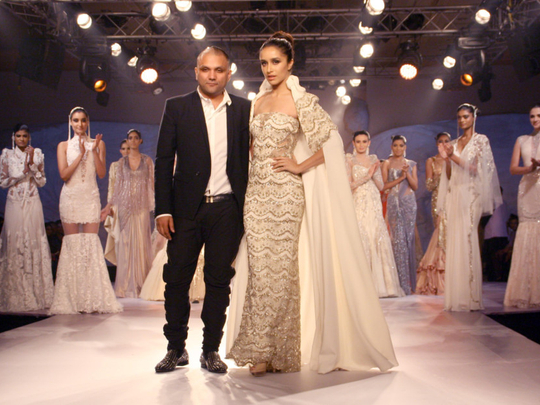
With names such as Sabyasachi, Rohit Bal, Manish Malhotra, Rina Dhaka and Manav Gangwani participating, this week’s celebration of India couture has not just grown over the last few years, it now has the backing of the biggest online portal, Amazon, and A-list French designer Christian Louboutin collaborating with one of the top designers in the country.
Amazon India Couture Week 2015 (AICW) kicks off on July 29 with five days of shows in New Delhi.
Yet, “couture” is still a new term in a country that has considered “fashion” mostly on the big screen or “designer wear”.
“For a country like India where fashion has started not too long ago, to have a couture week is indicative of the progress it has made in the industry,” Sunil Sethi, honorary president of Fashion Design Council of India, the organising body behind the couture week and India Fashion Week in October this year, told tabloid!.
“There was a time in India when designers designed only to establish themselves in the west. That was indicative of ‘you’ve made it’, the proverbial pat on their back. But with India Couture Week there was a dramatic shift — India started to celebrate its own fashion. And now we are probably only the third or the fourth country in the world to have a couture week,” said Sethi.
“Moreover, fashion in India was considered the luxury of the rich and famous only. Yes, the couture week is luxury and a top-end event. But today, leading designers, such as Sabyasachi, are affordable to a larger customer base. Similar pieces showcased during this event are now available starting from, maybe, Rs150,000 [Dh8,576]. Of course, it would be a toned-down version of what is shown here but it is still a Sabyasachi, isn’t it?”
Until about a decade ago, traditional Indian wear — even bridal — comprised a sari, a lehnga (a long embellished skirt, mostly worn with a bodice top), a kameez (long shirt) paired with a salwar (billowy trousers) or churidars (drainpipe trousers), or a sharara (long culottes-style trousers).
Now, while Indian designers are making a mark in the international market, they are also bringing western influences into traditional wear.
“Eight-nine years ago, how many women [in India] did we see wearing gowns or other dress styles? Everybody wanted a lehnga-choli for a wedding in a traditional colour of burgundy or a red or a Dilwale Dulhaniya Le Jayenge green lehnga. Couture week changed the dynamics of what can actually sell in the market,” said Sethi, who has been with the FDCI for the last eight years. “Today, it’s not just about an event, it’s a celebration of the bride and other [people] who are celebrating. So different versions of what can be imagined to be worn, are now actualities. At the same time, we now have a burgeoning red carpet market. Red carpet today doesn’t just mean wearing an exclusive sari but experimentation with a new style of dress, such as a sari-gown”.
Would this then define couture in India — because couture in the western world has a distinct character, clientele and definition?
“The fact that [every piece here] is made to order, it is specifically designed for a client, it is done by people who employ the best craftsmen and best in-house technicians, makes it as couture as it can get. The only concession I would make here is that [Indian] couture isn’t yet of the same purity as, say, French couture. We follow a similar procedure, only without a [governing] body such as Chambre Syndicale [de la Haute Couture] that would go and check all this and where designers need to receive admission before [their work] can be called couture. But guess what? Our Manish Arora who’s known for his kitsch [designs] is also a member there and has done fantastic shows for me over the years as part of Indian Couture Week. So what does that mean? This means this event has some sanctity”.
There is a jury made up of top retailers, fashion editors, experts in the industry, such as a dean of a fashion college, to select designers to showcase their pret and couture collections at FDCI events, said Sethi. The process is strict because the number of designers is in the thousands and membership is possible only to a few hundred.
“Selection is based on the level of one’s designs, not that a person may be working in the industry for 20 years or more,” said Sethi, who has decades of experience as a sourcing agent for various international high-street fashion and lifestyle brands such as Debenhams and Crate&Barrel. “Fashion is subjective and reputations are important. If someone has been selling couture for a time it is important, but at the same time giving an opportunity to people is what it’s all about. This year we have Rahul Mishra making his couture debut. The day we finish a multi-designer retail will showcase his collection, even before it is revealed.
“It may take time to reach the levels of Paris and Milan and London, but they started so many years ago. In couture at least, we have made tremendous progress in a much shorter time,” he added.
AICW 2015 kicks off with Sabyasachi on July 29 and will end with Manish Malhotra on August 2.













